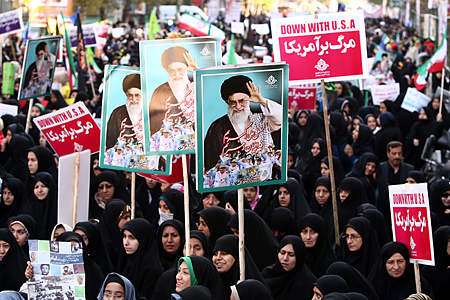
Iranian women hold anti-US signs and pictures of Supreme Leader Ayatollah Khamenei outside the former US embassy in Tehran on November 4, 2011, during a rally to mark the storming of the American embassy by Iranian students 32 years ago. (Photo: Atta Kenare / AFP / Getty Images)
Every nation has its pride, but the feeling runs especially deep in Iran. There, the sense of nationhood extends back 2,500 years, to the time of Darius and Xerxes and other names that Americans might possibly have heard of somewhere — maybe in the action movie 300 — but which anchor modern Iranians to a stream of history that predates every Abrahamic religion, including Islam, and carries real implications for the nuclear issue. For outsiders, it makes the issue a lot tougher.
Ordinary, rank and file, workaday Iranians want a nuclear program. Even those who dislike their government – likely a majority – crave the prestige afforded by atomic power, at the least. A few years ago I spent an afternoon exploring the question with Iranians while taking in the ruins of Persepolis, the ancient capital city of the Persian empire that was razed by Alexander the Great. One man pointed to a stone frieze showing a long line of supplicants bearing tribute to the Persian emperor from lesser lands. “These are Armenians,” he said, pointing to a group of three. “They were bringing gifts to the king of Iran 2,500 years ago. And now they have a nuclear power plant. Do you want to see the Indians?” he went on. “They didn’t have shoes. Now they have nine nuclear plants.”
Polls suggest a significant minority of Iranians – 38 percent in a 2010 University of Maryland survey – also think Iran should have The Bomb, even those aligned with the opposition Green Movement. It’s not nearly as clear that Iran’s religious rulers share that view: Ayatollah Ali Khamenei, who as Supreme Leader has far more power than President Mahmoud Ahmedinejad, has repeatedly said religious teachings proscribe weapons of mass destruction, and some of the savviest analysts, including Juan Cole , advise taking the mullah at his word. (Which doesn’t mean the government isn’t working hard to master the technology that could produce a nuclear weapon, as the IAEA reported last week. It’s entirely possible Iran merely wants the world to know it has the option of building one on short notice, as, say, Japan has.)
When Khamenei talks to his countrymen about nukes, the issue is framed in terms of progress, technology and, most importantly, development. The United States and its ilk, he says, “do not want an Islamic and independent country to achieve scientific progress and possess advanced technology.” He refers to the effort to master the nuclear fuel cycle as the work of “our own young experts” and “the talented Iranian nation.” Even if the findings of the IAEA show that, in fact, Iran’s nuclear program has drawn from Pakistani plans, North Korean parts and specific technical advice from a Russian, the point in question is essentially emotional. Khamenei’s rhetoric strikes a sensitive chord in a country that feels stuck in the mid-1970s — and knows the world has passed it by. Never mind the images that pour in from satellite television; Iranians travel. They don’t even need a visa to visit neighboring Turkey, which with the same population and even fewer resources has more than twice the per capita income.
Being left behind sits poorly with the descendants of a Persian civilization responsible for much of the Golden Age of Islam, the strides in medicine, astronomy and mathematics that piled up while Europe was mired in the Dark Ages. And Iranians will be sure to let you know that Persians were inventing things long before the arrival of Islam, an import carried there in 637 AD by invading Arabs, a desert people the plateau-dwelling Persians always thought of themselves as above, and not only topographically. Today a particularly tart put-down of the mullahs is dismissing them as “those Arabs,” lumping the clerics with the nomads that brought a faith started elsewhere, and imposed it on a civilization that had after all gotten to monotheism before anyone else: Zoroastrianism, which divides the world between light and dark, good and bad, was state religion of the Achaemenid emperors.
The list goes on. In a Tehran carpet shop, a salesman told me the tragedy of Persian history explained the shape of the paisley, or boteh, which originated in Iran; it looks a bit like a cypress tree. The tree was Iran, he said, and it had stood upright until Islam was laid on top, bending to one side the weak top branches. For a while, after taking power in the 1979 Revolution, the mullahs objected to naming babies for ancient pre-Islamic monarchs – Cyrus, Darius. (It didn’t help that the reviled Shah had explicitly invoked their legacy with a famous, decadent 1971 ceremony by the ruins of Persepolis.) The mullahs also discouraged observance of Nowruz, the spring festival of the new year, because it also predates Islam. In both cases, the people simply ignored them.
None of which is to suggest that Iranians are not devout Muslims. A very great many are, and they — along with the world’s 1.5 billion other believers — may well take an attack on Iran’s nuclear facilities as an attack on Islam. But for most Iranians, their religious identity rests atop a national one, and that’s the identity that guarantees ferocious popular ire against Israel, or America, or any other nation with the capacity to bomb the place, however they feel about the government ruling it at the moment. In fact, as analysts such as Karim Sadjadpour tirelessly point out, a military attack likely would give the theocratic government an unprecedented mandate for power, fusing the regime to the defense of the nation with a fire the clerics can no longer produce on their own.

